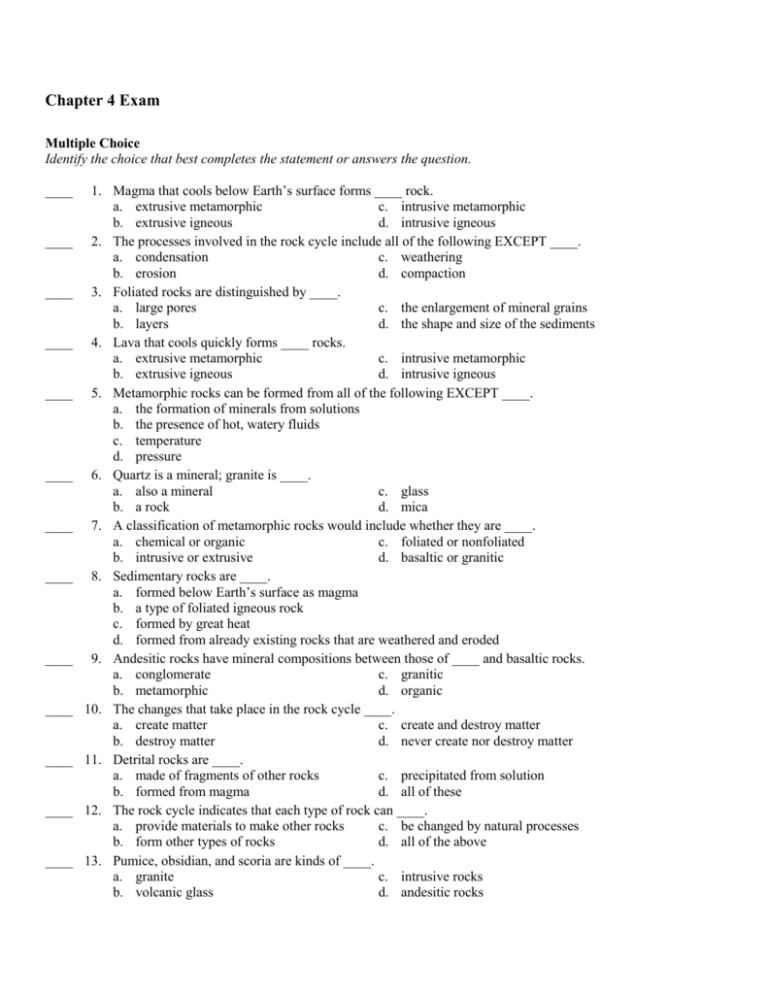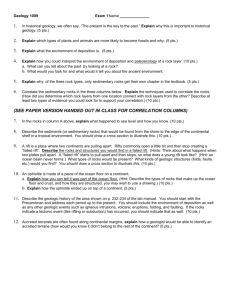Chapter 4 Exam.doc
advertisement

Chapter 4 Exam Multiple Choice Identify the choice that best completes the statement or answers the question. ____ ____ ____ ____ ____ ____ ____ ____ ____ ____ ____ ____ ____ 1. Magma that cools below Earth’s surface forms ____ rock. a. extrusive metamorphic c. intrusive metamorphic b. extrusive igneous d. intrusive igneous 2. The processes involved in the rock cycle include all of the following EXCEPT ____. a. condensation c. weathering b. erosion d. compaction 3. Foliated rocks are distinguished by ____. a. large pores c. the enlargement of mineral grains b. layers d. the shape and size of the sediments 4. Lava that cools quickly forms ____ rocks. a. extrusive metamorphic c. intrusive metamorphic b. extrusive igneous d. intrusive igneous 5. Metamorphic rocks can be formed from all of the following EXCEPT ____. a. the formation of minerals from solutions b. the presence of hot, watery fluids c. temperature d. pressure 6. Quartz is a mineral; granite is ____. a. also a mineral c. glass b. a rock d. mica 7. A classification of metamorphic rocks would include whether they are ____. a. chemical or organic c. foliated or nonfoliated b. intrusive or extrusive d. basaltic or granitic 8. Sedimentary rocks are ____. a. formed below Earth’s surface as magma b. a type of foliated igneous rock c. formed by great heat d. formed from already existing rocks that are weathered and eroded 9. Andesitic rocks have mineral compositions between those of ____ and basaltic rocks. a. conglomerate c. granitic b. metamorphic d. organic 10. The changes that take place in the rock cycle ____. a. create matter c. create and destroy matter b. destroy matter d. never create nor destroy matter 11. Detrital rocks are ____. a. made of fragments of other rocks c. precipitated from solution b. formed from magma d. all of these 12. The rock cycle indicates that each type of rock can ____. a. provide materials to make other rocks c. be changed by natural processes b. form other types of rocks d. all of the above 13. Pumice, obsidian, and scoria are kinds of ____. a. granite c. intrusive rocks b. volcanic glass d. andesitic rocks ____ 14. A rock is ____. a. always made of molten material b. a mixture of minerals, organic matter, volcanic glass, or other materials c. a pure mineral d. either igneous or sedimentary ____ 15. The crystals that form in slowly cooling magma are generally ____. a. nonexistent c. tiny b. invisible d. large ____ 16. Detrital rocks are named according to ____. a. their ages c. the size and shape of the sediments b. their locations d. the color of the sediments ____ 17. Sedimentary rocks are usually classified as ____. a. intrusive or extrusive c. basaltic, granite, or andesitic b. foliated or nonfoliated d. detrital, chemical, or organic Matching Match the terms with their descriptions below. a. granitic b. metamorphic rocks c. rock cycle d. sedimentary rocks e. cementation f. basaltic g. rock h. extrusive ____ ____ ____ ____ ____ ____ ____ ____ ____ ____ ____ ____ ____ ____ ____ 18. 19. 20. 21. 22. 23. 24. 25. 26. 27. 28. 29. 30. 31. 32. i. j. k. l. m. n. o. sediments igneous rocks compaction intrusive foliated lava nonfoliated rocks formed by changes in heat and pressure or the presence of hot, watery fluids rocks formed from molten material rocks formed from sediments igneous rocks formed on or near Earth’s surface layered metamorphic rocks process by which sediments are pressed together to form rock light-colored igneous rocks with a lower density than basaltic rocks dense, dark-colored igneous rocks metamorphic rocks that don’t have layers process by which large sediments are glued together by dissolved minerals to form rock igneous rocks formed below Earth’s surface bits of weathered rock, minerals, grains, plants, and animals that have been eroded model that illustrates the processes that create and change rocks magma that reaches Earth’s surface and flows from volcanoes a mixture of minerals, organic matter, volcanic glass, or other materials Identify each rock as igneous, metamorphic, or sedimentary. a. igneous b. metamorphic c. sedimentary ____ 33. sandstone ____ ____ ____ ____ ____ ____ 34. 35. 36. 37. 38. 39. granite rock salt obsidian gneiss slate limestone Short Answer 40. Suppose you found an igneous rock that had almost even amounts of silica, iron, and magnesium. How would you classify this rock? Why? 41. How do detrital, chemical, and organic sedimentary rocks differ from one another? 42. Your friend challenges you to tell what you know about a rock without seeing it. You are given a one-word hint: clastic. What can you tell your friend about the rock? 43. What makes the rock cycle a “cycle”? 44. What is cementation? 45. Use the information about igneous rocks A–D to classify each one as intrusive or extrusive and basaltic or granitic. Fill in the chart with A, B, C, or D. Rock A—dark-colored large grains Rock B—large crystals, high percentage of silica Rock C—fine-grained texture, light-colored Rock D—from Hawaiian volcano area, no visible crystals Extrusive Intrusive Basaltic 1. 2. Granitic 3. 4. 46. In a concept map, would you list basaltic lava under high silica content or low silica content? 47. In a concept map, would you list intrusive rocks under rocks that form above the ground or below? 48. If you were shown one photograph of pumice and one of granite, how could you distinguish between the two rocks? Directions: For each item, tell which event would occur first. 49. Molten material cools and forms igneous rocks. Lava flows from a volcano. 50. Gneiss is formed. The mineral grains in granite are flattened under pressure. 51. Describe the differences among detrital, chemical, and organic rocks. 52. Where does the rock cycle begin? Identify each statement as true or false. Rewrite false statements to make them correct. 53. The composition of a sedimentary rock depends upon the composition of the rocks and living things its sediments came from. 54. All igneous rocks have the same mineral compositions. 55. Nonfoliated rocks have very narrow layering. 56. Sedimentary rock can be formed from changes in igneous rock, but igneous rock cannot be formed from changes in sedimentary rock. 57. Metamorphic rocks can form from other metamorphic rocks. 58. Metamorphic rocks can form from igneous but not from sedimentary rocks. Chapter 4 Exam Answer Section MULTIPLE CHOICE 1. 2. 3. 4. 5. 6. 7. 8. 9. 10. 11. 12. 13. 14. 15. 16. 17. ANS: ANS: ANS: ANS: ANS: ANS: ANS: ANS: ANS: ANS: ANS: ANS: ANS: ANS: ANS: ANS: ANS: D A B B A B C D C D A D B B D C D PTS: PTS: PTS: PTS: PTS: PTS: PTS: PTS: PTS: PTS: PTS: PTS: PTS: PTS: PTS: PTS: PTS: 1 1 1 1 1 1 1 1 1 1 1 1 1 1 1 1 1 MATCHING 18. 19. 20. 21. 22. 23. 24. 25. 26. 27. 28. 29. 30. 31. 32. ANS: ANS: ANS: ANS: ANS: ANS: ANS: ANS: ANS: ANS: ANS: ANS: ANS: ANS: ANS: B J D H M K A F O E L I C N G PTS: PTS: PTS: PTS: PTS: PTS: PTS: PTS: PTS: PTS: PTS: PTS: PTS: PTS: PTS: 1 1 1 1 1 1 1 1 1 1 1 1 1 1 1 33. 34. 35. 36. 37. ANS: ANS: ANS: ANS: ANS: C A C A B PTS: PTS: PTS: PTS: PTS: 1 1 1 1 1 38. ANS: B 39. ANS: C PTS: 1 PTS: 1 SHORT ANSWER 40. ANS: The rock is andesic. It has a mineral composition between granitic and basaltic rock. Granitic rocks have a lot of silica but less iron and magnesium. Basaltic rocks have a lot of iron and magnesium but less silica. PTS: 1 41. ANS: Detrital rocks form by compaction and cementation of rock fragments and bits of minerals, plants, and animals; chemical rocks form from minerals dissolved in solution and deposited after evaporation; biochemical rocks form from the remains of once-living things compacted and cemented together. PTS: 1 42. ANS: The word “clastic” means that the rock has a broken texture. It could be a detrital sedimentary rock or an organic rock. PTS: 1 43. ANS: There is no beginning or end. Rocks are constantly changing from one form to another. PTS: 1 44. ANS: Cementation occurs when water soaks through rock, picking up atoms and molecules released from minerals during weathering. This solution of water and dissolved materials moves through open spaces between sediments. Minerals are deposited between the pieces of sediments, holding the particles together like glue, making a detrital sedimentary rock. PTS: 1 45. ANS: 1. D 2.. A 3. C 4. B PTS: 1 46. ANS: low silica content PTS: 1 47. ANS: below PTS: 1 48. ANS: Granite has visible crystals; pumice has no visible mineral grains and is full of holes. PTS: 1 49. ANS: Lava flows from a volcano PTS: 1 50. ANS: The mineral grains in granite are flattened under pressure. PTS: 1 51. ANS: Detrital, chemical, and organic rocks are all sedimentary rocks, but they form in different ways. Detrital rocks are made from broken fragments of other rocks. These sediments are compacted and cemented together. Chemical sedimentary rocks form when minerals are precipitated from a solution or are left behind when a solution evaporates. Organic rocks form from the remains of once-living things. PTS: 1 52. ANS: It has no beginning; rocks are constantly changing form from one type to another. PTS: 1 53. ANS: True PTS: 1 54. ANS: False, igneous rocks are formed from three basic types of lava—basaltic, andesic, and granitic PTS: 1 55. ANS: False, foliated rocks have tightly-pressed-together layers (or) nonfoliated rocks have no layers PTS: 1 56. ANS: False, sedimentary rock can form from changes in igneous rock; igneous rock can form from changes in sedimentary rock PTS: 1 57. ANS: True PTS: 1 58. ANS: False, metamorphic rocks can form from igneous and sedimentary rocks PTS: 1







